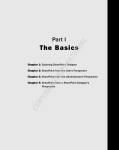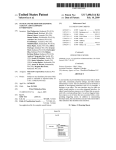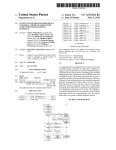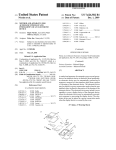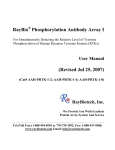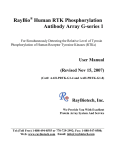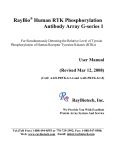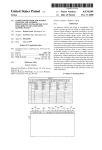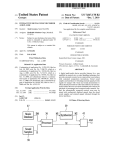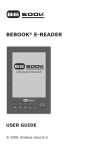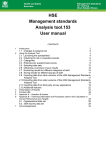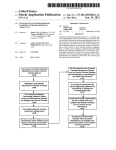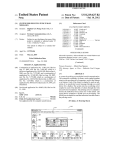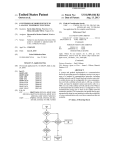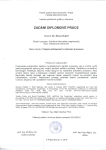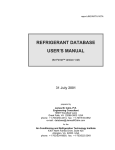Download System and method for context-sensitive help in a design environment
Transcript
US007937688B2
(12) Ulllted States Patent
(10) Patent N0.:
Vaidyanathan et al.
(54)
(45) Date of Patent:
SYSTEM AND METHOD FOR
5,499,371 A *
CONTEXT_SENSITIVE HELP IN A DESIGN
5,522,079 A *
5,699,310 A *
ENVIRONMENT
_
(75)
_
Inventors: Shankar Valdyanathan, Sammam1sh,
5,815,830 A
9/1998
5,359,636 A
1/1999 Pandit ,,,,,,, u
715/236
707/758
345/335
8/1999 Miller et al.
717/148
6,085,201 A
7/2000
707/505
6,122,647 A
9/2000 Horowitz etal.
Biliana K_
’
_
6,163,879
Ass1gnee: Microsoft Corporation, Redmond, WA
A
12/2000
Tso .............. ..
Mackey
. . . . . . . . .
704/9
707/513
. . . . . ..
717/1
6,182,274 B1 *
1/2001 Lau ,,,,,,,,,, n
(US)
6,269,475 B1
6,289,513 B1*
7/2001
9/2001
Farrell et al.
Bentwich ............. ..
U-S~C~
Subject~154(1))
to any by
disclaimer,
995 days~
~ the term ofthis
6,367,068
,
,
B1
4/2002
glgl‘iyana?ianl
Vaidyanathan
u man‘ ‘ e
‘‘‘ ‘a
‘ ‘ ‘ .‘ et
etal.
‘ ‘ .....
‘ ‘ a1~
‘ ‘ ‘ ..
“ ........
‘n’.. 717/8
Notice:
(21)
Appl.No.: 11/672,558
6,502,233 B1
Feb 8 2007
’
(65)
Prior Publication Data
US 2007/0168909 A1
_
_
717/104
..... .. 717/2
717/106
12/2002 Vaidyanathan et a1. .... .. 717/101
6,571,232 B1*
5/2003 Goldberg etal. ................... .. 1/1
6,697,825 B1
2/2004 Underwood et al. ..
6,788,317 B2*
7,003,522 B1
9/2004 Gardas et al. ............... .. 715/762
2/2006 Reynar et al.
7,065,745 B2
*
707/530
6/2006 ‘Chan ~~~~~~~~~~~~~~~~~~~~~~~~~~~ ~~ 717/117
(Contmued)
Jul. 19, 2007
OTHER PUBLICATIONS
Related US. Application Data
_
Henninger, S., et al., “A tool for managing software development
Cont1nuat1on of appl1cat1on No. 10/218,222, ?led on
Aug. 12, 2002, now abandoned.
knOW1edge:,PROFES, Bomarius, F‘, etal‘ (Eds), ZOOLLNCSZlss,
182-195.
(51) Int- 0-
(Continued)
G06F 9/44
(52)
(58)
Anthony ...... ..
717/108
5/2000 DeMaster
_
_
Garloffet al. .... ..
9/1998 Van DeVanter
5,946,647 A
( * )
(63)
12/1997
5,813,019 A *
6,066,181 A *
_
Filed;
3/1996 Henninger et al. ......... .. 717/108
5/1996 Acker er a1, ~~~~~ ~~
717/170
WA (US); Randy S. Kimmerly,
-’
(22)
May 3, 2011
Woodinville WA
Kaneva’ Klrkland’ WA (Us)
(73)
US 7,937,688 B2
(2006.01)
US. Cl. ....................... .. 717/111; 717/106; 717/112
Field of Classi?cation Search ...................... .. None
Primary Examiner 4 Jason Mitchell
(74) Azwrney, Agem, or Firm i Woodcock Washburn LLP
See application ?le for complete search history.
(57)
(56)
References Cited
An intelligent tool for assisting a developer during the cre
ation or maintenance of software generates an icon when
U.S. PATENT DOCUMENTS
4,674,065 A
4,796,179 A *
5,267,155 A
triggered by input. Upon selection of the icon, options are
6/1987 Lange et a1. ................ .. 364/900
1/1989
ABSTRACT
Lehman et a1. ............ .. 700/86
11/1993 Buchanan et a1.
.364/41914
5,392,386 A
2/1995
5,452,449 A
9/1995 Baldwin, Jr. et a1. ....... .. 355/600
displayed for potential selection. Upon selection of an entry,
event associated with the entry are deployed.
Chalas ........................ .. 395/155
3 Claims, 5 Drawing Sheets
UsorTypaOodu
5.01
"O
HolpTrlgqorod?
50.3.
YES
Dlspllylcon
Hi
Dlsmlu Icon
an
Icon saluted?
5H1
Dllplly Lin
M1
Perfon'n AGIIOII
51!
YE‘
EnhySallchd?
5.11
"
US 7,937,688 B2
Page 2
Middel, C.D., “Software Con?guration and Change Management”,
Proceedings 5’h Conference on Quality Engineering in Software
US. PATENT DOCUMENTS
1/2008 Arayasantiparb et al.
7,325,194 B2
7,346,892 B2 *
7,707,024
7,707,496
7,742,048
2002/0062475
2002/0083415
B2
B1
B1
A1*
A1*
3/2008
Shou et al. .................. .. 717/112
4/2010 Arayasantiparb et al.
4/2010 Abbar et al.
6/2010 Abbar et al.
Lin, C.F. et al., “Chinese Text Distinction and Font Identi?cation by
5/2002
Iborra et al.
6/2002
JaZdZewski .
. 717/111
2002/0104072 A1*
8/2002
Ecker et al. .
. 717/110
2003/0093769 A1*
5/2003 Kumar
2003/0221184 A1*
2003/0233632 A1*
2006/0090154 A1*
2006/0206866 A1*
................ .. 717/108
11/2003 Gunjal et al.
12/2003 Aigen et al.
4/2006
9/2006
Technology, 2001, 239-245 (English Language Abstract).
Jewell, D. “Windows Shell Secrets”, EXE, 1999, 13(9), 35-45.
Kramer, B. “3D LISP Tools”, Cadence, 1989, 4(5), 130-134.
. 717/108
. 717/118
. 717/106
Bustelo et al. .
. 717/110
Eldrige et al. .............. .. 717/122
Recognizing most Frequently Used Characters”, Image and J/lsion
Computing, 2001, 19, 329-338.
Willisson, Pace, et al., ISPELL: UNIX Man Pages, Aug. 23, 2003, 73
ages.
SED(1), BSD Reference Manual, sedMan.txt, 6 pages, Dec. 30,
1993.
McMahon, L .E., “SEDiA Non-Interactive Text Editor”, Bell Labo
OTHER PUBLICATIONS
ratories, Aug. 15, 1978, 10 pages.
The Complete Red Hat® LinuxTM Operating System 5.2 Deluxe,
Macmillan Digital Publishing, USA, 385 pages, 1998.
KucZa, T., et al., “Improving knowledge management in software
reuse process,” PROFES, Bomarius, F., et al., (Eds), 2001, LNCS
CoStar User’s Manual, “For AddressMate and AddressMate Plus”,
CoStar Corp., 1994-1995, pp. 1-1thruIndex-210.
Beitner, N.D. et al., “Multimedia Support and Authoring in Micro
2188,141-152.
Breidenbach, G., “Programmable Keyboard Controller”, Electronic
Praxis, 2001, 6, 68-70 (English Language Abstract).
Holmes, N., “Seven Great Blunders of the Computing World”, Com
puter, 2002, 110-112.
Zagler, W.L., “Text Generation for Disabled Persons Using Word
Prediction”, OE GAI-Journal, 2001, 20(2), 21-22 (English Language
Abstract).
IBM Research/Eclipse, http://www.research.ibm.com/eclipse,Home
page ,2 pages, Sep. 29, 2003.
JetBrains IntelliJ IDEAithe best Java IDE around, http://www.
intellij.com, 1 page, Sep. 23, 2009.
Slickedit;Code Editor, C++ Editor, Java Editor, HTML Editor, XML
Editor, Unicode Editor, http://www.slickedit.com, 1 page, Sep. 29,
2003.
Source Insight Program Editor and Analyzer, http://www.sourcedyn.
com/index.html, 2 pages, Sep. 29, 2003.
Borland, CodeWrightiThe Programmer’s Editing System, http://
www.premia.com, 1 page, Sep. 29, 2003.
Chalmers-Physical Resource Theory, “The Complex Adaptive Sys
tems Programme of year 2000”, http://www.frt.fy.chalmers.se/
kristian/software.html, 1 page, Sep. 29, 2003.
Emacs/W3 v 4.0, http://www.cs.indiana.edu/elisp/w3/docs.html, 1
page, Sep. 29, 2003.
Vi: A Unix text editor, http://www.indiana.edu/~ucspubs/b104/Ztoc.
html, 8 pages, Sep. 29, 2003.
Anderson, K.M. et al., “Chimera: Hypertext for Heterogeneous Soft
ware Environments”, Association for Computing Machinery, 1994,
ECHT '94 Proceedings, Department of Information and Computer
Science, University of California, Irvine California, USA, 94-107.
Hughes, G. et al., “Microsoft Smart Tags: Support Ignore or Con
demn Them?”, Association of Computing Machinery, Jun. 11-15,
2002, 80-81.
Lewis, P.H. et al., “Media-based Navigation with Generic Links”,
Association of Computing Machinery, 1996, The Multimedia
Research group, Department of Electronics and Computer Science,
University of Southampton, England, 215-223.
cosm: An Extended Model”, Department of Electronics and Com
puter Science, University of Southampton, 12 pages, 1994.
IBM Research Disclosure #368, “Multimedia Hyperlinks Automati
cally Created for Reference Documents”, Jun. 1993, 5 pages.
Microsoft® Of?ce 97 User’s Manual, “Getting Results with
Microsoft® Of?ce 97iReal World Solutions for the WorkYou Do”,
1997, 1-703.
Corel® Corporation Limited, Corel® InfoCentral User’s Manual,
1996, vol. 1, Version 7.0 , 1996, 1 thru 86.
Corel® Of?ce Professional 7 Quick Results, 1-531, 1993.
Novell® GroupWiseTM User’s Guide for Windows 16-Bit, Version
5.2,1993-1997, 1-231.
Novell® Group WiseTM User’s Guide for Windows 32-Bit, 1998,
Novell, Inc., 1-318.
Claris for Macintosh, Claris Emailer Getting Started, 1995-1997,
Claris Corporation, 61 pages.
Developer’s Guide to Apple Data DetectorsiFor Version 1.0.2, ©
Apple Computer, Inc., 1997, 1-34.
Apple Data Detectors User’s Manual, © 1997 Apple Computer, Inc.,
1-16.
Nardi, B.A. et al., “Collaborative, Programmable Intelligent Agents”,
Mar. 1998, Apple Computer advanced Technology Group, 1-11.
Ye, et al., Integrating Active Information Delivery and Reuse Repo si
tory Systems, 2000, AMC SIGSOFT, 60-68.
U.S. Appl. No. 09/907,418, ?led Jul. 17, 2001, Reynar et al.
US. Appl. No. 09/906,467, ?led Jul. 16, 2001, Reynar et al.
US. Appl. No. 09/906,552, ?led Jul. 16, 2001, Reynar et al.
US. Appl. No. 10/020,343, ?led Dec. 10, 2001, Hough et al.
US. Appl. No. 09/995,224, ?led Nov. 26, 2001, Klein et al.
US. Appl. No. 09/841,265, ?led Apr. 24, 2001, Reynar.
U.S. Appl. No. 09/841,266, ?led Apr. 24, 2001, Reynar.
U.S. Appl. No. 09/191,757, ?led Nov. 13, 1998, Vaidyanathan et al.
US. Appl. No. 09/588,411, ?led Jun. 6, 2000, Reynar et al.
US. Appl. No. 10/179,438, ?led Jun. 25,2002, Reynar, et al.
US. Appl. No. 10/179,810, ?led Jun. 25,2002, Helfrich, et al.
* cited by examiner
US. Patent
May 3, 2011
Sheet 1 015
US 7,937,688 B2
mEaéOCMm
aU
E_o o _
US. Patent
May 3, 2011
Sheet 2 of5
US 7,937,688 B2
IDE 2 1
FILE/DATABASE
E2
LANGUAGE SERVICE
2_0&
CONTEXT
SENSITIVE HELP
EDITOR
TOOL
2_0Z
225
SOURCE CODE
20_6
Fig. 2
US. Patent
May 3, 2011
Sheet 3 of5
US 7,937,688 B2
lDE m
EDITOR Q
SOURCE CODE WINDOW
K306
Class MyClass : lFoo
%
-_
Fig. 3
US. Patent
May 3, 2011
Sheet 4 of5
US 7,937,688 B2
IDE21
EDITOR m
SOURCE CODE WINDOW
f 306
3g
Class MyClass : lFoo
Insert Stubs? m
Fig. 4
US. Patent
May 3, 2011
”
Sheet 5 of5
User Types Code
5m
US 7,937,688 B2
‘_‘
Help Triggered?
Q92
Dismiss List
m
Display Icon
§Q§
Dismiss Icon
Icon Selected?
501
Display List
£1
Perform Action
5.5
Entry Selected?
511
Fig. 5
US 7,937,688 B2
1
2
SYSTEM AND METHOD FOR
CONTEXT-SENSITIVE HELP IN A DESIGN
ENVIRONMENT
helpful if there Were a tool that could track the intentions of a
user and proffer up a list of options of potential next tasks,
based on the user’s action.
CROSS-REFERENCE TO RELATED
APPLICATIONS
SUMMARY
This application is a continuation of patent application Ser.
No. 10/218,222, ?led Aug. 12, 2002, the entire disclosure of
during a program development or program maintenance
operation and displays an icon When user input triggers a
Which is hereby incorporated by reference in its entirety.
potential next task or tasks. Upon selection of the icon, the
tool proffers a list of possible next tasks. Upon selection of an
A context-sensitive design time tool monitors user input
FIELD OF THE INVENTION
entry in the list, the task is automatically performed.
This invention relates to the ?eld of computing and in
particular to the ?eld of development tools.
BRIEF DESCRIPTION OF THE DRAWINGS
BACKGROUND
description of preferred embodiments, is better understood
When read in conjunction With the appended draWings. For
The foregoing summary, as Well as the folloWing detailed
Programming languages have become more poWerful over
time through the addition of features and capabilities. The
increased poWer and capability of languages has been accom
panied by an increase in complexity. As softWare increases in
complexity, the development of software is becoming more
and more di?icult. Source code may exceed hundreds of
pages in length and may involve the use of many different
source code ?les and programming libraries. The number and
complexity of functions available to a softWare developer has
the purpose of illustrating the invention, there is shoWn in the
20
mentalities disclosed. In the draWings:
FIG. 1 is a block diagram of an exemplary computing
environment in Which aspects of the invention may be imple
25
FIG. 2 is a block diagram of a system that generates a
greatly increased. For example, multiple functions or meth
30
used, including typedefs, variables, macros, parameters,
screen shot of a section of source code in an editor, shoWing
the appearance of an icon in accordance With one aspect of the
invention;
namespaces, templates, attributes and so on. Each of these
FIG. 4 is a block diagram illustrating a representative
identi?ers typically requires a type declaration and/or de?ni
tion speci?ed. Hence programming tools that make develop
mented;
context-sensitive list of potential next tasks in accordance
With one embodiment of the invention;
FIG. 3 is a block diagram illustrating a representative
ods Within a class hierarchy may share the same name (or
identi?er), but have different numbers of parameters or dif
ferent parameter types. A large number of identi?ers may be
draWings exemplary constructions of the invention; hoWever,
the invention is not limited to the speci?c methods and instru
screen shot of a section of source code in an editor, shoWing
35
a list of potential tasks in accordance With one aspect of the
ment efforts easier and more accurate are Widely desired.
invention; and
One Way to make the task of the developer more manage
able is to establish an Integrated Development Environment
context-sensitive list of potential next tasks in accordance
(IDE). These environments typically include broWsers and
editors enabling developers to edit multiple source ?les. For
object oriented languages, the IDE may also provide a
broWser that enables a developer to navigate and vieW the
class hierarchy. To further assist the programming effort an
IDE may support some kind of on-line statement building
mechanism such as the one described in US. Pat. No. 6,311,
FIG. 5 is a How diagram of a method for generating a
With one embodiment of the invention.
40
DETAILED DESCRIPTION OF THE INVENTION
Exemplary Computing Environment
45
323 B1 issued Oct. 30, 2001, entitled “Computer Program
ming Language Statement Building and Information Tool”. A
be understood, hoWever, that handheld, portable, and other
help information mechanism may enable a developer to refer
to on-line documentation describing varying function de?ni
tions. In addition, an IDE may provide automatic help mod
ules displaying reference information associated With identi
50
IDE, as described in US. Pat. No. 6,305,008 B1, issued Oct.
16, 2001 entitled, “Automatic Statement Completion”. Such a
tool may be invoked as a developer is Writing code, and may
display a list of potential completion candidates to the devel
oper. The developer may then pick the desired candidate or
computing devices of all kinds are contemplated for use in
connection With the present invention. While a general pur
pose computer is described beloW, this is but one example,
and the present invention requires only a thin client having
netWork server interoperability and interaction. Thus, the
present invention may be implemented in an environment of
?ers and so on, as described in US. patent application Ser.
No. 09/191,757, ?led Nov. 13, 1998, entitled “Automated
Help Information for Reference Information”, now US. Pat.
No. 6,502,233. A completion module for auto-completion of
programming statements may also be available Within the
FIG. 1 and the folloWing discussion are intended to provide
a brief general description of a suitable computing environ
ment in Which the invention may be implemented. It should
netWorked hosted services in Which very little or minimal
55
client resources are implicated, e.g., a netWorked environ
ment in Which the client device serves merely as a broWser or
interface to the World Wide Web.
Although not required, the invention can be implemented
via an application programming interface (API), for use by a
60
developer, and/or included Within the netWork broWsing soft
Ware Which Will be described in the general context of com
continue typing, freeing the developer from having to consult
puter-executable instructions, such as program modules,
printed or on-line documentation, class hierarchies or other
being executed by one or more computers, such as client
source code ?les.
To date hoWever, a tool that can intelligently understand
Workstations, servers, or other devices. Generally, program
65
modules include routines, programs, objects, components,
What the user (e.g., developer) is doing and help the user
data structures and the like that perform particular tasks or
accomplish the next set of tasks is not knoWn. It Would be
implement particular abstract data types. Typically, the func
US 7,937,688 B2
3
4
tionality of the program modules may be combined or dis
tributed as desired in various embodiments. Moreover, those
skilled in the art Will appreciate that the invention may be
set or changed in such a manner as to encode information in
the signal. By Way of example, and not limitation, communi
cation media includes Wired media such as a Wired netWork or
practiced With other computer system con?gurations. Other
automated teller machines, server computers, hand-held or
direct-Wired connection, and Wireless media such as acoustic,
RF, infrared, and other Wireless media. Combinations of any
of the above should also be included Within the scope of
computer readable media.
The system memory 130 includes computer storage media
laptop devices, multi-processor systems, microprocessor
in the form of volatile and/or nonvolatile memory such as read
based systems, programmable consumer electronics, net
Well knoWn computing systems, environments, and/or con
?gurations that may be suitable for use With the invention
include, but are not limited to, personal computers (PCs),
processing devices that are linked through a communications
only memory (ROM) 131 and random access memory
(RAM) 132. A basic input/output system 133 (BIOS), con
taining the basic routines that help to transfer information
betWeen elements Within computer 110, such as during start
up, is typically stored in ROM 131. RAM 132 typically con
netWork or other data transmission medium. In a distributed
tains data and/ or program modules that are immediately
computing environment, program modules may be located in
both local and remote computer storage media including
memory storage devices.
accessible to and/or presently being operated on by process
ing unit 120. By Way of example, and not limitation, FIG. 1
Work PCs, minicomputers, mainframe computers, and the
like. The invention may also be practiced in distributed com
puting environments Where tasks are performed by remote
FIG. 1 thus illustrates an example of a suitable computing
system environment 100 in Which the invention may be
illustrates operating system 134, application programs 135,
20
other program modules 136, and program data 137.
The computer 110 may also include other removable/non
implemented, although as made clear above, the computing
removable, volatile/nonvolatile computer storage media. By
system environment 100 is only one example of a suitable
computing environment and is not intended to suggest any
Way of example only, FIG. 1 illustrates a hard disk drive 141
that reads from or Writes to non-removable, nonvolatile mag
netic media, a magnetic disk drive 151 that reads from or
Writes to a removable, nonvolatile magnetic disk 152, and an
limitation as to the scope of use or functionality of the inven
tion. Neither should the computing environment 100 be inter
preted as having any dependency or requirement relating to
25
optical disk drive 155 that reads from or Writes to a remov
able, nonvolatile optical disk 156, such as a CD ROM or other
any one or combination of components illustrated in the
exemplary operating environment 100.
optical media. Other removable/non-removable, volatile/
With reference to FIG. 1, an exemplary system for imple
menting the invention includes a general purpose computing
nonvolatile computer storage media that can be used in the
exemplary operating environment include, but are not limited
30
to, magnetic tape cassettes, ?ash memory cards, digital ver
satile disks, digital video tape, solid state RAM, solid state
ROM, and the like. The hard disk drive 141 is typically
device in the form of a computer 110. Components of com
puter 110 may include, but are not limited to, a processing
unit 120, a system memory 130, and a system bus 121 that
couples various system components including the system
memory to the processing unit 120. The system bus 121 may
be any of several types of bus structures including a memory
bus or memory controller, a peripheral bus, and a local bus
using any of a variety of bus architectures. By Way of
example, and not limitation, such architectures include Indus
35
try Standard Architecture (ISA) bus, Micro Channel Archi
tecture (MCA) bus, Enhanced ISA (EISA) bus, Video Elec
tronics Standards Association (VESA) local bus, and
Peripheral Component Interconnect (PCI) bus (also knoWn as
40
computer readable instructions, data structures, program
modules and other data for the computer 110. In FIG. 1, for
example, hard disk drive 141 is illustrated as storing operating
MeZZanine bus).
Computer 110 typically includes a variety of computer
system 144, application programs 145, other program mod
45
readable media. Computer readable media can be any avail
able media that can be accessed by computer 110 and includes
both volatile and nonvolatile media, removable and non-re
movable media. By Way of example, and not limitation, com
puter readable media may comprise computer storage media
and communication media. Computer storage media includes
both volatile and nonvolatile, removable and non-removable
media implemented in any method or technology for storage
of information such as computer readable instructions, data
structures, program modules or other data. Computer storage
media includes, but is not limited to, RAM, ROM, EEPROM,
?ash memory or other memory technology, CDROM, digital
versatile disks (DVD) or other optical disk storage, magnetic
cassettes, magnetic tape, magnetic disk storage or other mag
netic storage devices, or any other medium Which can be used
to store the desired information and Which can be accessed by
computer 110. Communication media typically embodies
computer readable instructions, data structures, program
connected to the system bus 121 through a non-removable
memory interface such as interface 140, and magnetic disk
drive 151 and optical disk drive 155 are typically connected to
the system bus 121 by a removable memory interface, such as
interface 150.
The drives and their associated computer storage media
discussed above and illustrated in FIG. 1 provide storage of
ules 146, and program data 147. Note that these components
can either be the same as or different from operating system
134, application programs 135, other program modules 136,
and program data 137. Operating system 144, application
programs 145, other program modules 146, and program data
50
147 are given different numbers here to illustrate that, at a
minimum, they are different copies. A user may enter com
mands and information into the computer 110 through input
devices such as a keyboard 162 and pointing device 161,
commonly referred to as a mouse, trackball or touch pad.
55
Other input devices (not shoWn) may include a microphone,
joystick, game pad, satellite dish, scanner, or the like. These
and other input devices are often connected to the processing
unit 120 through a user input interface 160 that is coupled to
the system bus 121, but may be connected by other interface
60
and bus structures, such as a parallel port, game port or a
universal serial bus (U SB).
A monitor 191 or other type of display device is also
connected to the system bus 121 via an interface, such as a
modules or other data in a modulated data signal such as a
video interface 190. A graphics interface 182, such as North
carrier Wave or other transport mechanism and includes any 65 bridge, may also be connected to the system bus 121. North
information delivery media. The term “modulated data sig
nal” means a signal that has one or more of its characteristics
bridge is a chipset that communicates With the CPU, or host
processing unit 120, and assumes responsibility for acceler
US 7,937,688 B2
5
6
ated graphics port (AGP) communications. One or more
tion. The system includes a context-sensitive potential next
task determiner 205, a ?le/database 203 (optional), a lan
guage service 204 and an editor 202 Within a design environ
ment 201 for drafting and editing source code 206. Those of
graphics processing units (GPUs) 184 may communicate
With graphics interface 182. In this regard, GPUs 184 gener
ally include on-chip memory storage, such as register storage
and GPUs 184 communicate With a video memory 186. GPUs
184, hoWever, are but one example of a coprocessor and thus
a variety of coprocessing devices may be included in com
ordinary skill in the art Will appreciate that the design envi
ronment 201 may also include other components, not shoWn
in FIG. 2. Source code 206 typically is a set of instructions
that a programmer or developer types or edits, and is Written
in a given programming language or combination of pro
puter 110. A monitor 191 or other type of display device is
also connected to the system bus 121 via an interface, such as
a video interface 190, Which may in turn communicate With
video memory 186. In addition to monitor 191, computers
may also include other peripheral output devices such as
gramming languages. Source code typically comprises one or
more statements, each statement typically comprising one or
more expressions and/or entities. The expressions and/or
speakers 197 and printer 196, Which may be connected
through an output peripheral interface 195.
entities in the statement can be made up of multiple compo
nents. Source code 206 may be persisted onto a stable storage
medium.
The computer 110 may operate in a netWorked environ
ment using logical connections to one or more remote com
puters, such as a remote computer 180. The remote computer
180 may be a personal computer, a server, a router, a netWork
PC, a peer device or other common netWork node, and typi
cally includes many or all of the elements described above
Editor 202 in one embodiment is part of an Integrated
Development Environment (IDE) 201, and facilitates the
20
development of the source code 206 of a computer program.
Editor 202 may be a C++ editor, a C# editor, a Visual Basic
editor, a J# editor or the like.
25
Language service 204 may be optimiZed for use With
Visual C++ code, With Visual C# code, With Visual Basic
code, With Visual Java # code or the like. The programming
languages anticipated for inclusion in the list of available
language services includes the above mentioned, COBOL
and any other suitable languages associated With program
relative to the computer 110, although only a memory storage
device 181 has been illustrated in FIG. 1. The logical connec
tions depicted in FIG. 1 include a local area netWork (LAN)
171 and a Wide area netWork (WAN) 173, but may also
include other netWorks. Such networking environments are
commonplace in of?ces, enterprise-Wide computer netWorks,
intranets and the Internet.
When used in a LAN networking environment, the com
puter 110 is connected to the LAN 171 through a netWork
interface or adapter 170. When used in a WAN netWorking
environment, the computer 110 typically includes a modem
172 or other means for establishing communications over the
WAN 173, such as the Internet. The modem 172, Which may
be internal or external, may be connected to the system bus
121 via the user input interface 160, or other appropriate
mechanism. In a netWorked environment, program modules
development.
30
35
depicted relative to the computer 110, or portions thereof,
may be stored in the remote memory storage device. By Way
of example, and not limitation, FIG. 1 illustrates remote
application programs 185 as residing on memory device 181.
It Will be appreciated that the netWork connections shoWn are
exemplary and other means of establishing a communications
link betWeen the computers may be used.
One of ordinary skill in the art can appreciate that a com
puter 110 or other client device can be deployed as part of a
40
parser may parse only a subset of the source code, (e.g., the
current function or method being edited). The parser may
include heuristics to ignore certain non-fatal errors, such as
but not limited to missing statement terminators, missing
like. Similarly language service 204 may include an auto
matic statement completion module, an automated help mod
ule and/or a statement building and information tool as
45
described above.
Language service 204 may include a compiler, such as but
not limited to, a C++ compiler, a C# compiler, a Visual Basic
compiler and/ or a J# compiler. Typically a compiler includes
a parser and a component that builds executable code. A
50
With server computers and client computers deployed in a
netWork environment, having remote or local storage. The
present invention may also apply to a standalone computing
parser receives input in the form of sequential source program
instructions, interactive online commands, markup tags, or
some other de?ned interface and breaks them up into parts.
For example a parser may break source code into nouns
device, having programming language functionality, inter
pretation and execution capabilities.
applicable to the programming language (e.g., a C++ parser,
a C# parser, a Visual Basic parser, a J# parser or the like). The
closing parenthesis, missing function terminators and the
computer netWork. In this regard, the present invention per
tains to any computer system having any number of memory
or storage units, and any number of applications and pro
cesses occurring across any number of storage units or vol
umes. The present invention may apply to an environment
Language service 204 may include a dynamic parser as
described in US. Pat. No. 6,367,068 B1 issued on Apr. 2,
2002, entitled “Dynamic Parsing”. Such a parser may operate
to parse the source code 206 according to the parsing rules
55
Context-Sensitive Help in a Development Environment
A context-sensitive design-time tool dynamically monitors
(objects), verbs (methods), and their attributes or options. A
parser may also check to see that all necessary input has been
provided.
Language service 204 preferably includes context-sensi
user (e.g., developer) input during softWare development.
potential next task(s) is displayed. Upon selection of an entry,
tive tool 205. Alternatively, the context-sensitive tool may
exist external to language service 204. The context-sensitive
next-task help tool 205 parses user keystrokes for a triggering
the task is automatically performed. Automatically-per
character or sequence of characters, as the keystrokes are
When the tool intelligently determines a potential next task or
tasks, an icon is generated. Upon selection of the icon, a list of
60
input. Upon detection of a triggering character or sequence of
characters, the tool determines potential next tasks.
formed tasks include, but are not limited to, automatically
inserting code into a source program.
FIG. 2 is a block diagram illustrating an exemplary system
for monitoring user input and proffering a list of potential
next tasks in accordance With one embodiment of the inven
65
For example, in the case of adding method stubs to an
interface, entering the interface name as part of the class
de?nition is the triggering event.
US 7,937,688 B2
8
7
For example, suppose the user types:
service 204). Alternatively, a ?le or database in memory (not
shoWn) may be accessed, (for example, a Visual Basic com
class CFoozpublic lBar
the input of “lBar” following “class Cfoozpublic” triggers the
piler symbol table stored in a database in memory). Tables,
display of an icon. Upon further user input, as described
beloW, the automatic addition of stubs for all the methods of
?les, databases and the like, Whether stored in memory on
persisted to a stable storage medium are contemplated by the
invention. Alternatively, ?le/database 203 While appearing as
one database to the user, actually may be comprised of mul
tiple stores or databases. For example, a ?rst database (e.g., a
lBar can be effected.
As another example, assume that a developer has Written an
interface such as the following:
project database) may be dynamically updated by the parser,
as described above. In addition, the pre-built database may
contain information that seldom changes, such as the operat
interface lEmployee
{
ing system de?nitions and header ?les, and MFC/ATL class
string Name { get; set; }
int Age { get; set; }
de?nitions and header ?les referred to above. Those of ordi
nary skill in the art Will recogniZe that other class de?nitions
and header ?les could be included in the pre-built database.
One or more pre-built databases may exist.
Assume also, that the developer has Written several classes
that implement this interface. Each of these classes therefore
have a ‘Name’ property and an ‘Age’ property, as required by
Continuing the example described above, in Which method
20
stubs for an interface can be automatically generated, assume
the folloWing line of code Was entered:
the contract of the interface.
class CFoozpublic lBar
Next, say the developer realiZes that the lEmployee inter
face also needs a ‘Salary’ property. Using the code editor, the
developer may change the interface to look like this:
Upon entering “lBar” folloWing “class CFoozpublic”, the
methods of lBar are retrieved by accessing database 203. In
25
this case database 203 includes a list of all the methods of
lBar.
As another example, assume the developer is authoring a
neW class, and declares it to implement an interface called
‘lEnumerable’. At this point in accordance With one embodi
interface lEmployee
string Name { get; set; }
int Age { get; set; }
decimal Salary { get; set; }
ment of the invention, an icon Would be displayed, Which,
30
upon selection, provides an entry offering to provide stub
implementations of all the members of lEnumerable to the
neW class, since that is a requirement of implementing the
}
interface. The database 203 contains the information about
At the point When the neWly added property is complete in
the editor, an icon Would appear, and When clicked or other
35
the interface lEnumerable, including the names and signa
tures of the methods it has, What interfaces it extends, etc. It
Wise selected, an option to automatically add stub implemen
tations of the ‘Salary’ property to all classes that implement
should be understood that the examples recited above are
exemplary only and any suitable content for and use of data
lemployee Would be displayed.
base 203 is contemplated by the invention.
Another exemplary triggering sequence is usage of some
speci?c API (Application Programming Interface) such as
“SQLConnect”. Entering “SQLConnect” indicates that the
Thus, in accordance With one embodiment of the invention,
40
next set of tasks to be performed is to use the SQL connection
to retrieve or input data to the database. It should be under
stood that the particular examples are exemplary only and
other suitable triggering sequences are contemplated.
In determining potential next tasks, ?le/database 203 may
45
the developer concerning potential next-tasks. Upon selec
tion of one or more entries, the task or tasks associated With
50
bers Where an identi?er, token, or function name is de?ned or
parser. File/database 203 typically also includes information
not only from source code 206, but also includes information
from other sources including system header ?les, Microsoft
Foundation Class (MFC) header ?les and ActiveX Template
55
60
example, a C++ ?le generated by a portion of the language
The icon in one embodiment of the invention is displayed
in the editor near the triggering character or sequence of
characters. In response to user selection of the icon by posi
tioning a cursor over the icon or by selecting the icon in other
Ways knoWn in the art, a WindoW is generated, displaying a
list. The list preferably includes one or more potential next
task(s). Upon selection of an entry or a series of entries in the
list by clicking on the entry (or entries) or by selecting the
entry (or entries) using other Ways knoWn in the art, the task
associated With the list entry is automatically performed.
Libraries (ATL), all of Which are knoWn in the art. In one
embodiment of the invention, ?le/database 203 is referred to
as a No Compile BroWse (NCB) ?le. File/database 203 may
include a compiler symbol table (for example, a C# or J#
symbol table stored in a database), or a separate ?le (for
the entry or entries is performed. In one embodiment of the
invention, the event invoking the context-sensitive help mod
ule 205 is the entry of certain pre-determined programming
language-de?ned constructs.
erence information such as source ?le names and line num
referenced, as described in co-pending application Attorney
Docket No. MSFT-l249 ?led concurrently hereWith, entitled
“System and Method for BroWse lnforrnation Parsing With
out Compilation”, and is populated and maintained by the
tive help module 205. Context-sensitive help module 205
then displays an icon. If the icon is selected, context-sensitive
help module 205 parses the code fragment using information
from ?le/ database 203 to provide context-sensitive choices to
be accessed. File/database 203 may include information on
entities in the source code. File/database 203 typically is a ?le
comprising a database that, in one embodiment of the inven
tion, is used by the parser to store information including, but
not limited to, class de?nitions, member data types, and ref
the system of FIG. 2 operates as folloWs. A user (e.g., a
developer) drafts source code 206 With editor 202. As the
developer generates the source code 206, one of the compo
nents of IDE 201 detects an event and invokes context-sensi
FIG. 3 is a block diagram illustrating a representative
65
screen shot of a section of source code in an editor, shoWing
the appearance of an icon in accordance With one aspect of the
invention. FIG. 4 is a block diagram illustrating a represen
US 7,937,688 B2
10
ming conventions, is an integer, Which is re?ected in the code
generated by the tool. For example, in this case, the tool may
tative screen shot of a section of source code in an editor,
showing a list of potential tasks in accordance With one aspect
of the invention.
Within a design environment such as an Integrated Design
Environment (IDE) 201, a C++ editor 202 enables the cre
ation or editing of C++ source code 306 as depicted in Win
doW 308. Source code 306 is displayed Within WindoW 308.
Context-sensitive help tool 205 generates icon 302 When
generate the folloWing:
int method 1 ( )
return 0;
triggered by the keystrokes input by the user. Upon selection
oficon 302, icon 302 is dismissed and a list 402 ofpotential
tasks is displayed.
Alternatively, the return type may be HRESULT, resulting in
For example, assume that a developer is Writing C++ code
using the C++ language service 202. Assume a public inter
face class: “IFoo” exists in database 203, interface IFoo hav
ing tWo member methods, methodl and method2. Because
generation of:
HRESULT methodl ( )
IFoo is an interface, methodl and method2 are pure methods
and are not implemented. If, for example, a user types “class
result SiOK;
MyClass:public IFoo {” into source code 306, the context
sensitive tool Will detect that the user may intend to imple
ment the IFoo interface so that the pure virtual methods of
20
Similarly, if methodl has an input parameter of int i and an
IFoo Will need to be overridden in MyClass. Context-sensi
output parameter of an integer pointer, (methodl ([in] int i,
tive help tool 205 is triggered by the colon, the colon indicat
ing to the tool 205 that the Word that folloWs, (i.e., “IFoo”)
[out] int *p); the tool may generate code to make sure that p is
not equal to null, and may initialiZe the pointer so that the
probably is a class such as an interface or base class). The tool
25
folloWing may be generated by the tool:
HRESULT methodl (int i, int *p);
30
{
includes heuristics for determining possible next tasks (i.e.,
implement the interface by overriding any pure methods of
interface IFoo) and thereby determines that the user Will
probably Want to Write function bodies for methodl and
method2. Upon determining the possible next task or tasks,
the tool displays an icon 302 in the vicinity of the user input,
indicating that a potential next task has been determined.
Upon selection of the icon by hovering the cursor over the
icon, or otherWise selecting the icon using methods knoWn in
assert (p == null);
*P=0;
35
the art, the user is prompted With a statement such as but not
limited to: “Do you Want to implement stubs for interface
IFoo?”. Upon selection of the entry, or otherWise indicating
assent, using methods knoWn in the art, the function body stub
code Would be automatically generated in the user’s source
code instance. For example, in this case, the folloWing code
may be generated:
As much of the function body can be generated as can be
determined from the information available. In addition, for
example, address modi?ers and parameters and the like can
be generated.
As another example, in C#, interfaces may be implemented
40
publicly or privately. When stubs are generated, methods can
be marked private, in Which case the method can only be
called by casting an object to that speci?c interface. The
context-sensitive tool provides the option of generating
void method 1 ( )
45
either.
When typing code to make a connection to a database (e. g.,
SQL/OleDB), the context-sensitive tool generates code to
retrieve a dataset and subsequently close the database, using
ATL or SQL or other suitable database-handling languages.
}
void method2 ( )
50
For example, suppose a user types the folloWing connection
string into source code:
SQL
eliminating the need for the user to type in this code, and
eliminating any mistakes the user might make in the process,
userIShankar,
ence to a database and user folloWed by the sequence of letter
55
changes preferably Would also involve making the appropri
ate changes to the COM map, a macro Wrapped structure used
to track all the interfaces implemented by a given class. While
the example above relates to interfaces, it Will be understood
that the tool is intended to handle regular base classes as Well
(“Database:MySQL,
The context-sensitive tool, triggered in this case by the refer
and potentially increasing the productivity of the developer.
In the case of MFC/ATL in C++, accepting the icon’s
Connect
PWD:“hello”).
“PWD”, denoting “passWor ”, generates an icon Which,
When selected, proffers the option of hiding the passWord in a
registry, for example. Upon selection of the option, code
including that code needed to create the necessary user
60
classes, etc. is generated, the appropriate existing code is
removed and replaced With the tool-generated code.
as interfaces. With base classes, a subset or all of the base’s
virtual methods can be overridden.
When typing code, if a user sees a squiggly, a Wavy line
commonly used to denote an error condition of some sort, and
Similarly, it should be understood that although the above
example is simple, to aid in understanding, the generation of
hovers over the squiggly, the context-sensitive tool preferably
example, perhaps methodl is de?ned With attribute “integer”.
generates an icon proffering Ways to correct the code. The ?x
may include adding a missing semicolon or closing brace, or
identifying and correcting a typographical error in an unde
In this case, the return type, in accordance With C++ pro gram
?ned type. Alternatively, Knowledge Base (KB) articles (a
code is not restricted to beginning and ending braces. For
65
US 7,937,688 B2
11
12
good source of information regarding common issues or
questions) or Websites such as WWW.msdn.com may be
accessed by establishing a connection to the Internet to iden
construed as limiting of the present invention. While the
invention has been described With reference to various
embodiments, it is understood that the Words Which have been
used herein are Words of description and illustration, rather
than Words of limitation. Further, although the invention has
been described herein With reference to particular means,
materials and embodiments, the invention is not intended to
tify an appropriate correction.
When typing in a declaration of a function or method or
other element, implementation can be automatically gener
ated by accessing ?les generated by a compiler or dynamic
parser.
be limited to the particulars disclosed herein; rather, the
invention extends to all functionally equivalent structures,
Wizards presently invoked by identifying a correct node
and right-clicking on classvieW folloWed by ?lling in
methods and uses, such as are Within the scope of the
requested information are preferably eliminated by providing
appended claims. Those skilled in the art, having the bene?t
of the teachings of this speci?cation, may effect numerous
modi?cations thereto and changes may be made Without
departing from the scope and spirit of the invention in its
an option in the list to perform the task previously performed
by the WiZard.
Preferably, the IDE is open such that third parties can
author their oWn language services, thereby augmenting the
aspects.
features of the standard text editor to conform to their lan
guage (such as coloriZation of their syntax elements, provid
ing formatting and automatic indent capabilities, and the
like). Language services are also employed in the environ
ment to provide information to the various broWsers and help
systems, and also to provide useful information to the debug
ger if appropriate. In the context of this invention, the lan
What is claimed is:
1. A method of providing context-sensitive help using a
20
monitoring user actions during source code input;
detecting a triggering event in the monitored user actions;
guage service is given the opportunity to make use of the
context-sensitive help functionality in accordance With one
in response to detecting the triggering event, determining
embodiment of the invention so as to present the “next-task”
options While editing.
25
FIG. 5 is a How diagram of a method of providing context
sensitive help in accordance With one embodiment of the
invention. At step 501, as source code is entered or edited,
each keystroke or sequence of keystrokes is parsed to deter
mine if the keystroke or sequence of keystrokes is a context
30
At step 503, if it is determined that the keystroke or
sequence of keystrokes is not a context-sensitive help trigger,
processing returns to step 501. At step 503, if it is determined
When executed makes a connection to an external data
35
comprises hiding the passWord.
45
prising:
monitoring user actions during source code input;
detecting a triggering event in the monitored user actions;
50
in response to detecting the triggering event, determining
an action associated With the triggering event;
in response to determining the action associated With the
triggering event offering to execute the action; and
in response to the user accepting the offer, performing the
Upon selection of the icon, an entry may be displayed sug
55
associated action, Wherein an external data source is
accessed and Wherein sections of code comprising more
than a single Word are automatically entered into the
source code by the programming tool based on informa
tion stored in the external data source,
Where the type/method are referenced are modi?ed. It should
be understood that the example cited is merely exemplary and
any suitable actions and entries are contemplated by the
invention.
If an entry is not selected at step 513, the list is dismissed at
step 517, after a speci?ed period of time or upon positioning
the cursor elseWhere, and processing returns to step 501.
text-sensitive help using a programming tool that predicts
potential next-tasks, the computer-readable storage medium
having stored thereon computer-executable instructions com
generated by the context-sensitive help engine or a section of
gesting to modify all the places Where the type/method is
being referenced. Upon selection of the action, all the places
source code that speci?es a passWord for accessing the
external database, and Wherein the associated action
2. A computer-readable storage medium for providing con
?le may be removed and replaced With a section of code
code originally included Within the source code ?le may be
modi?ed.
For example, suppose a user is modifying the declaration/
de?nition of a type or method, an icon may be displayed.
base and Wherein the associated action comprises gen
erating code to retrieve a dataset speci?ed in the entered
code and to close the external database and entering the
generated code into the source code, Wherein the trig
gering event further comprises entering code in the
40
entries includes possible next actions that a user might take. If
one or more of the entries is selected at step 513, the action
associated With the entry or entries is performed at step 515
and a section of code Within a source code ?le may be added
or a section of code originally included Within the source code
accessed and Wherein sections of code comprising more
than a single Word are automatically entered into the
source code by the programming tool based on informa
tion stored in the external data source,
Wherein the triggering event comprises entering code that
sensitive help trigger, a context-sensitive help icon is gener
ated and displayed close to the triggering keystroke(s) at step
505. At step 507, if the icon is not selected Within a designated
time period, the icon is dismissed at step 509 and processing
returns to step 501. At step 507, if the icon is selected, a list of
entries is generated and displayed at step 511. The list of
an action associated With the triggering event;
in response to determining the action associated With the
triggering event offering to execute the action; and
in response to the user accepting the offer, performing the
associated action, Wherein an external data source is
sensitive help trigger.
that the keystroke or sequence of keystrokes is a context
programming tool that predicts potential next-tasks, the
method comprising:
60
Wherein the triggering event comprises entering code that
65
base and Wherein the associated action comprises gen
erating code to retrieve a dataset speci?ed in the entered
code and to close the external database and entering the
generated code into the source code, Wherein the trig
When executed makes a connection to an external data
CONCLUSION
It is noted that the foregoing examples have been provided
gering event further comprises entering code in the
merely for the purpose of explanation and are in no Way to be
source code that speci?es a passWord for accessing the
US 7,937,688 B2
13
14
external database, and wherein the associated action
is accessed and Wherein sections of code comprising
comprises hiding the password.
more than a single Word are automatically entered
3. A system for providing context-sensitive help using a
programming tool that predicts potential next-tasks compris
ing:
into the source code by the programming tool based
on information stored in the external data source,
Wherein the triggering event comprises entering code that
a processor;
memory having stored therein computer-executable
instructions comprising:
monitoring user actions during source code input;
detecting a triggering event in the monitored user
actions;
in response to detecting the triggering event, determin
ing an action associated With the triggering event;
in response to determining the action associated With the
triggering event offering to execute the action; and
in response to the user accepting the offer, performing
the associated action, Wherein an external data source
When executed makes a connection to an external data
base and Wherein the associated action comprises gen
erating code to retrieve a dataset speci?ed in the entered
code and to close the external database and entering the
generated code into the source code, Wherein the trig
gering event further comprises entering code in the
source code that speci?es a passWord for accessing the
external database, and Wherein the associated action
comprises hiding the passWord.














